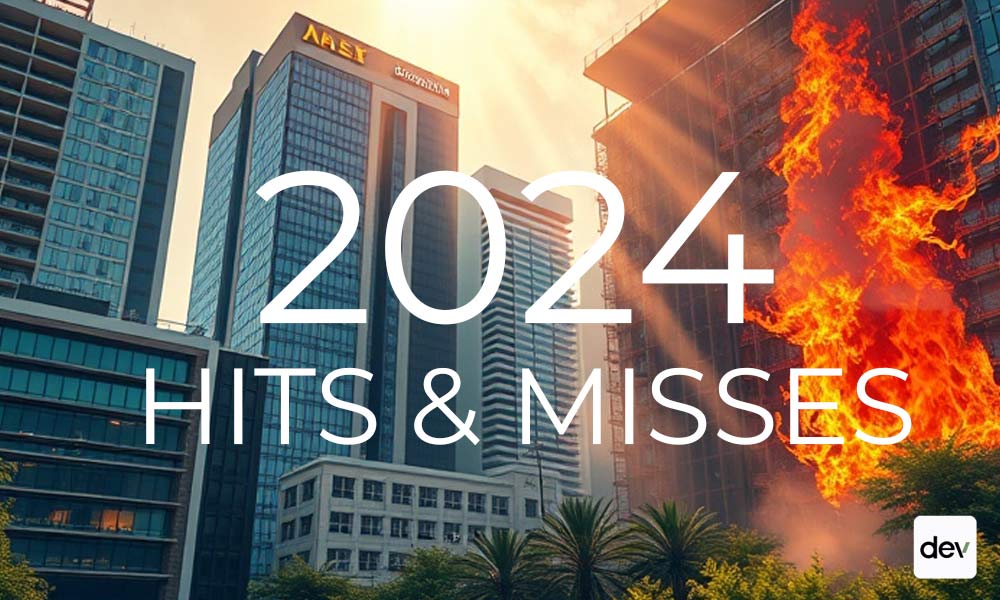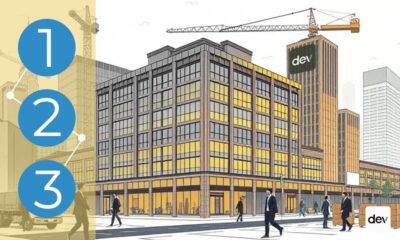
News
Commercial Real Estate 2024 Year in Review: Hits & Misses
Explore the key highlights & challenges of 2024 in commercial real estate. Discover the predictions & trends that shaped the industry this year.
When it comes to 2024 CRE predictions, a look back indicates that unexpected market forces caused a little havoc for forecasters.
“The big prediction was that markets would continue to fall,” said Kiran Raichura, chief commercial real estate economist for Capital Economics, and the author of Five Key Calls for U.S. Commercial Real Estate in 2024. “We saw the market fall, but not as much as predicted for 2024.”
The CRE industry review 2024 looks at some key indicators, and how the predictions fared against the reality of a turbulent year.
Overview of 2024 CRE Predictions
One key prediction from many sources was that the U.S. economy would collapse into a recession. Here’s how commercial real estate trends for 2024 have performed over the last 12 months.
“You look back at it, 2024, almost everyone’s forecast was that we’re going to have a bad, big recession (and) a really challenging year,” said Lukas Krause, CEO of SVN Commercial Real Estate Advisors in a CRE industry review. “It turned out to be more like a rolling recession. The labor market remained strong. You saw (the economy) hitting Tech a little bit.”
In January 2023, Raichura foresaw five key issues occurring in 2024:
• Continued decline in property values
• Retail sector outperformance
• Distress in the office and multi-family sectors
• Gradual recovery in market activity
• Elevate cap rates across sectors
Most other predictions looked at market values and recovery from the post-Covid downturn. The expectations were gloomy when made them a year ago. Many held.
“Property values dropped in 2024, but not as much as predicted,” Raichura said. “The (Morgan Stanley Capital International) Index reported falls in markets nationwide. Individual sectors performed differently.”
Krause said that in 2024, no one knew what would happen. The changes in the economy are different from anything anyone had experienced, he said.
Retail
Raichura believes that the retail sector post-COVID adjustment is complete.
“I wouldn’t call it a trend yet,” he said. “Retail values were up one percent in 2024, compared to a 14 percent drop in office values.”
Krause said that it’s hard to define a national trend in retail. “Yes, I mean, you’re seeing that with malls being converted to different uses, retail or office space,” Krause said. “I think that this shows a little more thoughtful use.”
Market performance in commercial real estate in 2024 was varied. According to Krause, migratory patterns are moving people to the warmer climates in the South and Southwest increasing retail demand.
“I think retail demand has been more prevalent depending on the markets,” he said. “It’s such a local piece, but in growing areas, you’re seeing more demand.”
On the other side, he said retail demand is slipping in many central cities and the Midwest.


Multifamily and Office
Although seeming an odd mix, multi-family and office commercial real estate were expected to follow similar patterns in 2024. Looking back, Raichura was satisfied his prediction was close to the money.
Increasing numbers in multifamily delinquencies and foreclosures occurred as he anticipated with expectations that interest and capital rates would continue rising in 2024.
Krause said early 2024 projections stressed that housing affordability—including multifamily—was going to weigh heavily on CRE investments. He was right. Raichura projected the weakness and said that by November, distressed properties were increasing at double-digit rates.
“So in terms of distress, we were basically talking about more loads coming delinquent for sales of assets where investors were either struggling to repay loans or valued them substantially so that those loans were called in. And we’ve seen that over the year.
Commercial mortgage-backed security of multi-family and office tracking data hit double digits in November, 10.4 percent.
“That means they are more than 30 days late on payment,” Raichura said. “Those are big increases from a year ago. We think there’s more to go as well.”
“I do look at the residential perspective,” Krause commented. “The affordability is very challenging, and you have this mass migration to desirable places with the flexibility of remote work.”


That population movement strains investment returns on CRE in markets losing population and pressures growing markets to try and find locations for new apartments and office spaces.
“After doing that ‘key calls’ piece in January (2024),” said Raichura. “I did a few other pieces on why (office and multifamily) would be distressed.”
He said that for offices, a significant value loss and the considerable loss of tenants because of remote work had lessees renegotiating downsized leases. Hundreds of older buildings that were once Class A were becoming obsolete.
“For multifamily, it’s much more about having relatively low debt service coverage ratios,” Raichura added. “Which is basically to say that they would initially originate loans with income from the asset not massively above the cost of servicing the debt.”
As occupancy dropped and interest rates rose in 2024, the debt costs have increased.
“We had multi-family rents increasing,” he said. “But (the rents) stopped increasing that much and flatlined as well.”
Adding to multifamily and office distress, costs have risen as values were projected to drop in 2024. In some regions, Raichura said, higher insurance costs and climbing vacancy rates created an increasing number of assets where debt levels are higher than income.
“Debt service coverage ratios dropped below one,” said Raichura. “Rent payments are not covering interest payments.”
Industrial, Flex, Warehouse and Data Centers
Despite evident construction in the industrial sector, Raichura said that values are dropping.
“I think in truth, certain industrial values have fallen a lot more than the index,” he said. “Forecasting suggested, and we’ve been saying this for at least a year or so, we think industrial will outperform in the coming year.”
Raichura explained that the falling values happened in the market and are reflected in appraisal-based indices. He said that the indices are far behind the current market.
ReZa Norozy, COO of Prism Construction said that interest rates were expected to drop in 2024, and they did, though not as much as hoped.
“I can say institutional investors wanted to turn to more secure assets,” he said. “Industrial is a safe investment generally.”
Krause agrees that the predictions early in 2024 for the industrial sector were a hit.
“There is even more momentum than expected in distribution, warehousing and data centers,” he said.
Major Surprises
Lots of capital was waiting to jump on distressed and foreclosed CRE. It didn’t happen. Several REITs with missions to do so were funded early in 2024 with far less capital than in previous years.
Bisnow reported that through November, only two funds raising $240 million were created. Two years earlier, 13 funds raised $4 billion.
Lessons Learned
Raichura, who is preparing his 2025 key trends report, said one thing he learned from his 2024 predictions is that the CRE market is plunging headfirst into unexplored territory. Projecting the future from the past is not like it used to be.
“We don’t know what’s going to happen,” Krause said. “It’s all kind of unprecedented (in 2024).”






